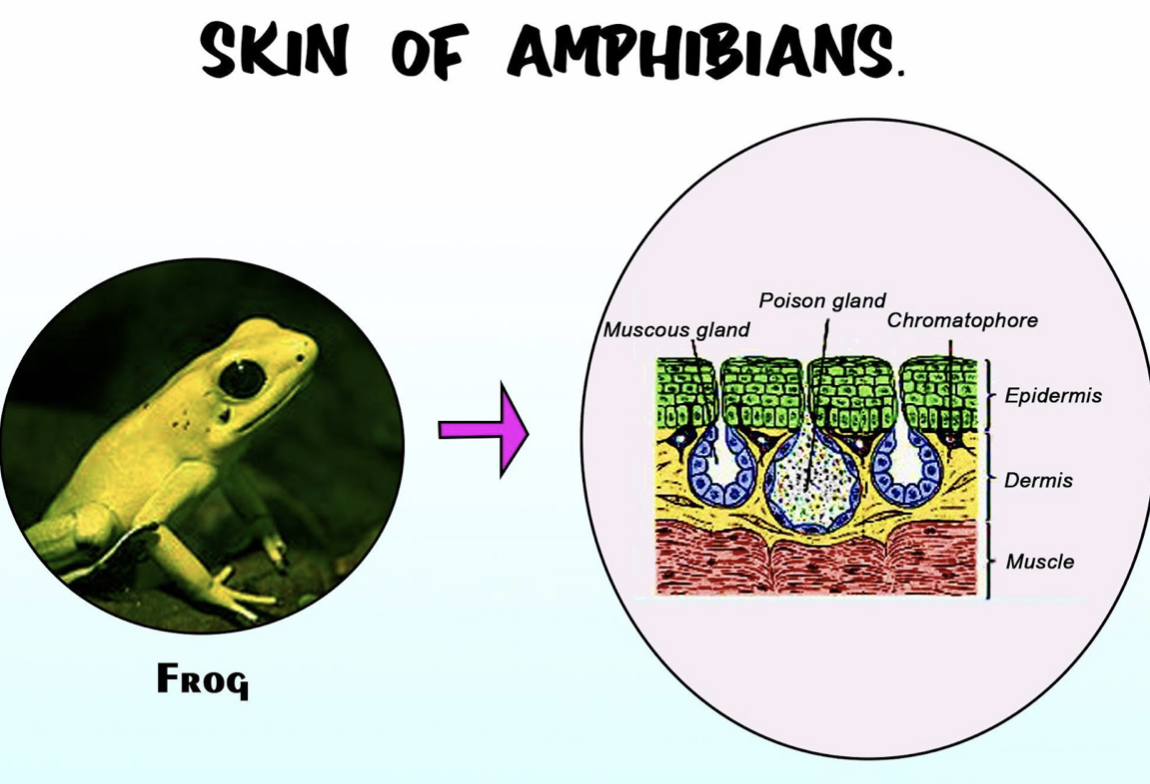
The amphibians are characterized by
(a) Only aquatic habit
(b) Monocondylar skull
(c) Scaleless, smooth moist, and glandular skin
(d) Claws present at the tip of digits
Answer
471.6k+ views
Hint: As tetrapods, four well-developed limbs characterize most amphibians. Some salamander species, and all Caecilians, are functionally limbless; they have vestigial limbs. There is a layer of amphibians which helps them perform cutaneous respiration.
Complete answer:
In water and on the ground, amphibians refer to double life, or life. The Amphibians are distinguished by damp, glandular skin that lacks reptile keratinized scales. Their bodies are scaleless.
A moist, permeable skin that is accomplished by mucus glands that hold the skin moist is an important feature of current amphibians; thus, oxygen and carbon dioxide can be shared with the atmosphere through it (cutaneous respiration).

Most amphibians have very permeable thin skin (allowing liquids and gases to easily pass through it). For two reasons, this is important. First, it means that, because oxygen flows easily through it, their skin lets them breathe. Second, it means that amphibians, through their skin, lose a lot of water.
Additional information: Some frogs, including waxy monkey frogs (Phyllomedusa sauvagil), have evolved a defensive mechanism in order to colonize arid habitats: a lipid is secreted from skin glands that the frog spreads with its feet over its body. The lipid helps retard water loss, forming a cocoon around the animal in essence. Many amphibian species create skin gland poisons that they use to defend themselves from predators; some species, such as some poison dart frogs (species of Dendrobates), have poisons that are strong enough to destroy humans.
So, the correct answer is, ‘(c) Scaleless, smooth moist and glandular skin’.
Note: A wide variety of colors and patterns can appear on the skin of amphibians. These features of the skin in many species help them blend into their natural environments in order to resist predation. Some amphibians, however, show vivid warning colorations and patterns that may include red, yellow, orange, and black hues, which act as a vivid indicator that they may be toxic to predators. Indeed, several species are equipped with skin glands, such as cane toads and poison arrow frogs that secrete powerful toxins.
Complete answer:
In water and on the ground, amphibians refer to double life, or life. The Amphibians are distinguished by damp, glandular skin that lacks reptile keratinized scales. Their bodies are scaleless.
A moist, permeable skin that is accomplished by mucus glands that hold the skin moist is an important feature of current amphibians; thus, oxygen and carbon dioxide can be shared with the atmosphere through it (cutaneous respiration).

Most amphibians have very permeable thin skin (allowing liquids and gases to easily pass through it). For two reasons, this is important. First, it means that, because oxygen flows easily through it, their skin lets them breathe. Second, it means that amphibians, through their skin, lose a lot of water.
Additional information: Some frogs, including waxy monkey frogs (Phyllomedusa sauvagil), have evolved a defensive mechanism in order to colonize arid habitats: a lipid is secreted from skin glands that the frog spreads with its feet over its body. The lipid helps retard water loss, forming a cocoon around the animal in essence. Many amphibian species create skin gland poisons that they use to defend themselves from predators; some species, such as some poison dart frogs (species of Dendrobates), have poisons that are strong enough to destroy humans.
So, the correct answer is, ‘(c) Scaleless, smooth moist and glandular skin’.
Note: A wide variety of colors and patterns can appear on the skin of amphibians. These features of the skin in many species help them blend into their natural environments in order to resist predation. Some amphibians, however, show vivid warning colorations and patterns that may include red, yellow, orange, and black hues, which act as a vivid indicator that they may be toxic to predators. Indeed, several species are equipped with skin glands, such as cane toads and poison arrow frogs that secrete powerful toxins.
Recently Updated Pages
The correct geometry and hybridization for XeF4 are class 11 chemistry CBSE

Water softening by Clarks process uses ACalcium bicarbonate class 11 chemistry CBSE

With reference to graphite and diamond which of the class 11 chemistry CBSE

A certain household has consumed 250 units of energy class 11 physics CBSE

The lightest metal known is A beryllium B lithium C class 11 chemistry CBSE

What is the formula mass of the iodine molecule class 11 chemistry CBSE

Trending doubts
Why was the Vernacular Press Act passed by British class 11 social science CBSE

Arrange Water ethanol and phenol in increasing order class 11 chemistry CBSE

Name the nuclear plant located in Uttar Pradesh class 11 social science CBSE

One Metric ton is equal to kg A 10000 B 1000 C 100 class 11 physics CBSE

What steps did the French revolutionaries take to create class 11 social science CBSE

How did silk routes link the world Explain with three class 11 social science CBSE




